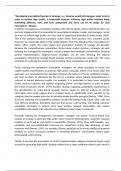“Developing prescriptive theories of strategy, i.e., theories would tell managers what to do in
order to achieve high profits, is impossible because achieving high profits requires doing
something different, new, and even unexpected and there can be no recipe for such
innovations”. Discuss.
In perfect, homogenous, competitive markets with rational agents, where rational decisions are
perfectly implemented, it is impossible for prescriptive strategies to exist, and managers cannot
do much to achieve high profits. No rules exist to outperform (Bromiley & James-Wade, 2003).
This is the standard classical economics model where firms produce zero economic profit.
However, we empirically observe that reality deviates from this. Relaxing these assumptions to
better reflect reality, this essay argues that prescriptive theories of strategy are possible.
Relaxing the competitiveness assumption, Porter-based market structure strategies do well.
Relaxing the homogeneity assumption, resource-based view strategies are beneficial. Relaxing
perfect implementation, diligence-based strategies can do well. Relaxing the rational
assumption, behavioural strategy-based strategic decision architecture works well. The essay
concludes by analysing the extent to which relaxing these assumptions are justified.
Firstly, relaxing the competitive assumption, managers can adopt strategies to create and
exploit market imperfections to generate high profit. Famously, Porter's five forces takes this
approach, as it recommends that managers influence the balance of forces, anticipate changes,
and react to them, to ultimately put the firm in a position where market competitiveness is
reduced to extract abnormal profits. For example, it is preferable to have lower industrial
rivalry, lowered customer and supplier bargaining power, and high barriers to entry to lower
the threat of entrants (Porter, 1979). Another strategy exploiting competitive imperfections is
the identification of under-priced strategic factors based on internal analysis of private
information that could suggest that a strategic factor is significantly more valuable to the
company than the market price due to privately known possible synergies (Barney, 1986). Firms
that have exploited non-competitive markets include ride-hailing (Grab, GoJek, Uber, Lyft) and
food delivery (Grubhub, Doordash) start-ups that pursue cash-burning, loss-making customer
acquisition strategies to achieve local level positive network externalities that reduce
competition and enable rent collection once sufficient market share is captured.
Secondly, relaxing the homogeneity assumption, managers can pursue resource-based view
models of strategy to generate high profit. Given resource heterogeneity, imperfect resource
mobility, ex post and ex ante limits to competition (Peteraf, 1993), firms with valuable, rare,
inimitable, and non-substitutable resources can outperform if they take advantage of their
resources well (Barney, 1991). For example, Disney capitalizes on its strong intellectual property
portfolio to launch successful ventures in streaming (Disney+), merchandise, theme parks
(Disneyland), and licensing.
Thirdly, if we relax the assumption of perfect implementation, diligence-based strategies could
succeed in generating high profit. Strategy suffers from a chess syndrome where it gets stuck in




